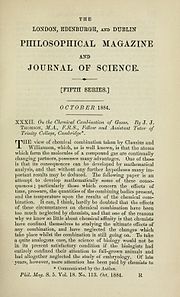J.J Thomson
 |
|
|
|
Sir Joseph John Thomson OM PRS (/ˈtɒmsən/; 18 December 1856 – 30 August 1940) was an English physicist and Nobel laureate in physics, credited with the discovery and identification of the electron; and with the discovery of the first subatomic particle.
In 1897, Thomson showed that cathode rays were composed of previously unknown negatively charged particles, which he calculated must have bodies much smaller than atoms and a very large value for their charge-to-mass ratio. Thomson is also credited with finding the first evidence for isotopes of a stable (non-radioactive) element in 1913, as part of his exploration into the composition of canal rays (positive ions). His experiments to determine the nature of positively charged particles, with Francis William Aston, were the first use of mass spectrometry and led to the development of the mass spectrograph.
Thomson was awarded the 1906 Nobel Prize in Physics for his work on the conduction of electricity in gases.
Joseph John Thomson was born 18 December 1856 in Cheetham Hill, Manchester, Lancashire, England. His mother, Emma Swindells, came from a local textile family. His father, Joseph James Thomson, ran an antiquarian bookshop founded by a great-grandfather. He had a brother two years younger than he was, Frederick Vernon Thomson. J. J. Thomson was a reserved yet devout Anglican.
...
Wikipedia


